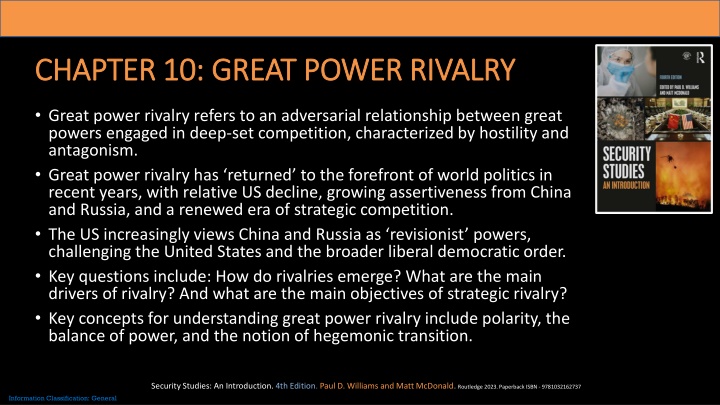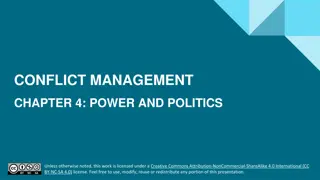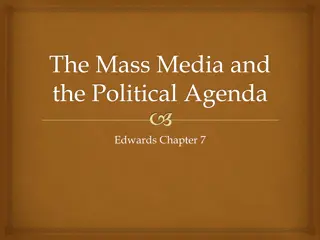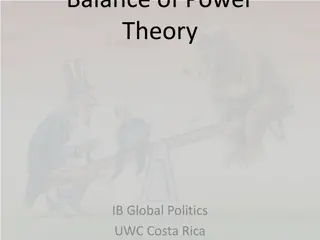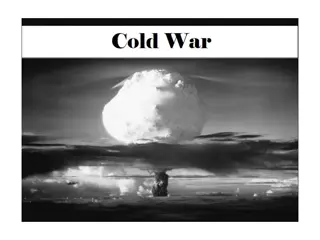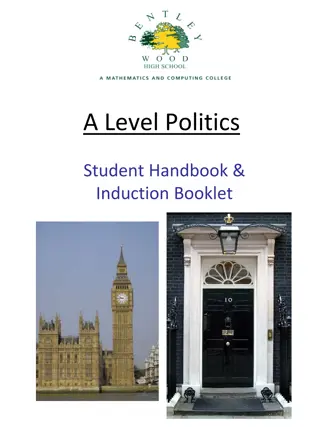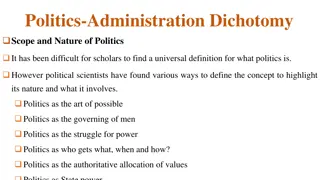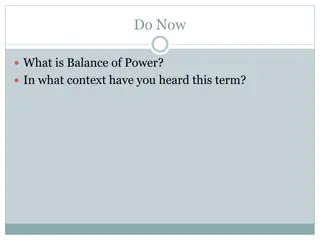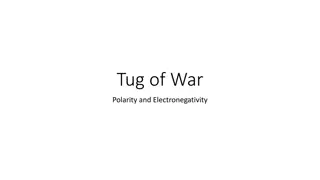Great Power Rivalry in World Politics: Understanding Polarity, Balance of Power, and Hegemonic Transition
Great power rivalry involves deep competition and hostility between major players like the US, China, and Russia. The concept is explored through polarity, balance of power, and hegemonic transition theories, discussing power distribution, strategies, and transitions in the international system. The return of great power rivalry raises questions about emerging rivalries, driving forces, objectives, and stability in global relations.
Download Presentation

Please find below an Image/Link to download the presentation.
The content on the website is provided AS IS for your information and personal use only. It may not be sold, licensed, or shared on other websites without obtaining consent from the author.If you encounter any issues during the download, it is possible that the publisher has removed the file from their server.
You are allowed to download the files provided on this website for personal or commercial use, subject to the condition that they are used lawfully. All files are the property of their respective owners.
The content on the website is provided AS IS for your information and personal use only. It may not be sold, licensed, or shared on other websites without obtaining consent from the author.
E N D
Presentation Transcript
CHAPTER 10: GREAT POWER RIVALRY CHAPTER 10: GREAT POWER RIVALRY Great power rivalry refers to an adversarial relationship between great powers engaged in deep-set competition, characterized by hostility and antagonism. Great power rivalry has returned to the forefront of world politics in recent years, with relative US decline, growing assertiveness from China and Russia, and a renewed era of strategic competition. The US increasingly views China and Russia as revisionist powers, challenging the United States and the broader liberal democratic order. Key questions include: How do rivalries emerge? What are the main drivers of rivalry? And what are the main objectives of strategic rivalry? Key concepts for understanding great power rivalry include polarity, the balance of power, and the notion of hegemonic transition. Security Studies: An Introduction. 4th Edition. Paul D. Williams and Matt McDonald. Routledge 2023. Paperback ISBN - 9781032162737 Information Classification: General
KEY CONCEPT 1: POLARITY KEY CONCEPT 1: POLARITY Polarity refers to the material distribution of power between states in the international system. It is usually summarized as the number of great powers in the system: Unipolarity: a system with a single preponderant power (e.g., immediate post- Cold War period). Bipolarity: a system with two great powers (e.g., the Cold War). Multipolarity: a system with three of more great powers (e.g., the pre-World War II system). Realist approaches to international relations generally suggest that a multipolar system is the most unstable and likely to feature significant conflict. More nuanced accounts of power distribution e.g., Brooks & Wohlforth (2016) distinguish between different types of power: great power, emerging potential superpower, potential superpower and superpower. Security Studies: An Introduction. 4th Edition. Paul D. Williams and Matt McDonald. Routledge 2023. Paperback ISBN - 9781032162737 Information Classification: General
KEY CONCEPT 2: BALANCE OF POWER KEY CONCEPT 2: BALANCE OF POWER Traditional balance of power theory states that structural logics compel great powers to balance against each other to prevent the rise of a predatory great power and hegemon. The fundamental objective of states is to check rising power, by enhancing their own military capabilities (internal balancing) and/or forming alliances to aggregate material power (external balancing). The balance of power has, however, been used in a range of ways: to describe a systemic condition; as an actual or ideal distribution of power; or as an account of particular forms of foreign policy behaviour. Two key critiques of balance of power approaches are: 1) its Eurocentric bias; 2) its relevance in the post-Cold War world. Security Studies: An Introduction. 4th Edition. Paul D. Williams and Matt McDonald. Routledge 2023. Paperback ISBN - 9781032162737 Information Classification: General
KEY CONCEPT 3: HEGEMONIC TRANSITION KEY CONCEPT 3: HEGEMONIC TRANSITION Hegemonic transition theory focuses on hierarchy as an ordering principle in world politics and when hegemons are replaced. A concentration of power encourages the preservation of peace and stability, as the preponderant state tries to maintain order by encouraging buy-in to that order from other states, socializing potential challengers to the norms, rules and practices of the existing order. A peaceful and stable transfer or power is likely where there is a broad consensus on the status quo by a rising contender e.g., as occurred in the power transition between the UK and US in the middle of the 20th century. The probability of war, however, increases under conditions of parity and dissatisfaction. Hegemonic transitions are bound up in material, ideational, social, and normative forces. Security Studies: An Introduction. 4th Edition. Paul D. Williams and Matt McDonald. Routledge 2023. Paperback ISBN - 9781032162737 Information Classification: General
US US- -CHINA RIVALRY: AN OVERVIEW CHINA RIVALRY: AN OVERVIEW US-China rivalry is arguably the most consequential bilateral relationship of the 21st century. Described by US President Joe Biden (2021) as America s most serious competitor , China s rise has raised critical questions about polarity shifts, power transitions, and the durability of US hegemony. Power balancing is now far more visible as the great powers explicitly balance each other, and as other states similarly engage in balancing behaviour to counter growing Chinese assertiveness. US-China strategic competition is playing out across multiple domains, amplified by hardening stances on both sides. Security Studies: An Introduction. 4th Edition. Paul D. Williams and Matt McDonald. Routledge 2023. Paperback ISBN - 9781032162737 Information Classification: General
US US- -CHINA RIVALRY SITE 1: SOUTH CHINA CHINA RIVALRY SITE 1: SOUTH CHINA SEA SEA South China Sea is one of the world s major shipping routes and home to competing sovereignty claims by Brunei, China, Malaysia, the Philippines, Taiwan, and Vietnam. It is a critical geostrategic arena for US-China competition, where the shifting regional distribution and balance of power hold important consequences for US hegemony and the rules-based international order. Beijing has placed significant emphasis on developing its capabilities as a maritime power and made expansive claims in the South China Sea within the nine-dash line . Beijing rejected the 2016 Permanent Court of Arbitration s tribunal ruling denying China any legal basis to its claims and has displayed more coercive behaviour e.g., harassment and intimidation of foreign states fishing boats and maritime vessels. The 2021 Coast Guard Law authorises the Chinese Coast Guard to remove unapproved foreign structures in its jurisdictional waters and to use force against any violation of China s sovereignty and maritime rights. China has also embarked on extensive island-building projects to advance its power projection capabilities. Washington increasingly views China as an expansionist and revisionist power, representing a clear challenge to US primacy and the region s rules-based order. In recent years, the US has increased its freedom of navigation operations to challenge China s excessive maritime claims in the South China Sea. Beijing views US actions as containing China and regularly calls out US hypocrisy in supporting an adherence to international law when the US itself has not ratified the United Nations Convention on the Law of the Sea (UNCLOS). Security Studies: An Introduction. 4th Edition. Paul D. Williams and Matt McDonald. Routledge 2023. Paperback ISBN - 9781032162737 Information Classification: General
US US- -CHINA RIVALRY SITE 2: ECONOMIC & CHINA RIVALRY SITE 2: ECONOMIC & TECHNOLOGICAL COMPETITION TECHNOLOGICAL COMPETITION China is currently the world s second largest economy and forecast to overtake the US to become the largest economy by 2030. In 2018, US President Donald Trump started a trade war with China that quickly escalated into a tit-for-tat tariffs dispute. The economic-technology-security nexus is especially salient in examining the implications of China s rising power for US hegemony. Although the US currently maintains technological superiority, China has emerged as a significant peer competitor. Not only has China boosted its R&D investment with the aim of achieving technological independence, Beijing is thought to enjoy longer-term comparative advantages in human capital. Countries looking to diversify their digital transformation may now look to China as an alternative technology partner. However, claims that China is a systemic enabler of global authoritarianism through its sale of frontier technologies run the risk of creating a self-fulfilling prophecy. Security Studies: An Introduction. 4th Edition. Paul D. Williams and Matt McDonald. Routledge 2023. Paperback ISBN - 9781032162737 Information Classification: General
US US- -CHINA RIVALRY SITE 3: GREY ZONE CHINA RIVALRY SITE 3: GREY ZONE ACTIVITIES ACTIVITIES Cyberspace has become an important instrument of statecraft and a relatively new, albeit increasingly strategic, domain for great power competition. Cyber operations are largely conducted in the grey zone between peace and war that is, they are coercive actions designed to influence, disrupt or sabotage an opponent in order to gain a competitive advantage, but remain below the threshold of open war. As the US and China race to achieve cyber superiority, they are dedicating immense resources to this domain, with cyber strategies now fully incorporated into their respective national security doctrines. Cyberspace is also now a critical battleground as the great powers compete for global influence and construct cognitive framings for how people perceive the world. During the COVID-19 pandemic, Beijing conducted disinformation campaigns to deflect blame, reframe strategic narratives, and boost its global image. This information contest is increasingly taking on an ideological dimension between democratic and authoritarian regimes. Security Studies: An Introduction. 4th Edition. Paul D. Williams and Matt McDonald. Routledge 2023. Paperback ISBN - 9781032162737 Information Classification: General
US US- -CHINA RIVALRY SITE 4: INSTITUTIONAL CHINA RIVALRY SITE 4: INSTITUTIONAL RIVALRY RIVALRY Institutions are understood here in broad terms to include organizations, initiatives, and coalitions. Whilst previously a passive participant in international institutions, China now practices a far more skilful institutional statecraft with greater agency to reshape or influence what counts as appropriate behaviour, determine which values governance structures to pursue, and reconceptualize authority in international society. Two China-led initiatives, the Asian Infrastructure Investment Bank (AIIB) and the Belt and Road Initiative (BRI), have gained global prominence. US policies are now more directly aimed at countering China s rising influence e.g., the Obama administration actively lobbied US allies and partners to resist joining the AIIB and the Biden administration s Build Back Better World initiative is designed to provide an alternative to the BRI. Security Studies: An Introduction. 4th Edition. Paul D. Williams and Matt McDonald. Routledge 2023. Paperback ISBN - 9781032162737 Information Classification: General
THE RETURN OF POWER POLITICS? THE RETURN OF POWER POLITICS? Great power rivalry appears to have returned to centre stage in international politics, with potentially significant implications for international security. Contemporary US-China rivalry is heating up over a wide range of issues. Misperceptions and miscalculations also create possibilities for intensified competition. Yet rivalries need not escalate into armed conflict and war. US-China rivalry may have returned but both countries can and should exercise restraint, moderate tensions, and make judicious choices to manage and stabilize their relationship. Security Studies: An Introduction. 4th Edition. Paul D. Williams and Matt McDonald. Routledge 2023. Paperback ISBN - 9781032162737 Information Classification: General
ESSAY / EXAM QUESTIONS ESSAY / EXAM QUESTIONS Great power rivalry has returned to international politics . Do you agree with this statement and what are the implications of your answer? What is the most important domain of contemporary great power competition? Explain your answer with reference to at least two examples. Is a unipolar, bipolar or multipolar international system the most stable, and why? Do you agree that states generally attempt to balance against other powerful states? Is hegemonic transition theory helpful for understanding whether a rising China will confront the US, including via armed conflict? Is war between China and the US inevitable? What are China s key objectives in the South China Sea? How should the United States respond? Did China conduct a successful global information campaign during the COVID-19 pandemic? Security Studies: An Introduction. 4th Edition. Paul D. Williams and Matt McDonald. Routledge 2023. Paperback ISBN - 9781032162737 Information Classification: General
WEBSITES AND AUDIO WEBSITES AND AUDIO- -VISUAL RESOURCES VISUAL RESOURCES Documentaries and Analysis: Films: CSIS Asia Maritime Transparency Initiative provides interactive maps about Asia s maritime claims, disputed reefs, islets, and more: https://amti.csis.org/maps/ Dr Strangelove (1964): https://www.youtube.com/watch?v=jPU1AYTxwg4 Bridge of Spies (2015): https://www.youtube.com/watch?v=7JnC2LIJdR0 Bloomberg Quicktake, The Militarization of the South China Sea , (2021), https://www.youtube.com/watch?v=BHCkZbBwFyM The Hunt for Red October (1990): https://www.youtube.com/watch?v=NSiAsQMBSRA CNA Insider, A US-China Tech War: The True Costs , When Titans Clash, Ep 3/4 (2021), https://www.youtube.com/watch?v=w8XnLW26bmg&list=PLkMf14VQ EvTbTGw6gbmIHoWz4nmolfkpU&index=7 American Factory (2019): https://www.youtube.com/watch?v=m36QeKOJ2Fc CNA Insider, US-China: Is a New NATO Emerging in Asia? , When Titans Clash 2, Part 1/3, (2022), https://www.youtube.com/watch?v=- d2GPC1SEOI Graham Allison, Is War Between China and the US inevitable? , TED (2018): https://www.youtube.com/watch?v=XewnyUJgyA4 Hacked, Inside the US-China Cyberwar , Al Jazeera (2022): https://www.youtube.com/watch?v=OQv47FywPhQ Henry Kissinger, We are now living in a totally new era , Financial Times (2022): https://www.youtube.com/watch?v=6b89jcNqgJo John Mearsheimer and David Kang, Debate: Should the US Seek to Contain China? , Quincy Institute for Responsible Statecraft (2021): https://www.youtube.com/watch?v=wafCm3fmF7s Michael Beckley, US-China relations Explained , WIRED (2021): https://www.youtube.com/watch?v=RUUdC6n4s2Y Security Studies: An Introduction. 4th Edition. Paul D. Williams and Matt McDonald. Routledge 2023. Paperback ISBN - 9781032162737 Information Classification: General
